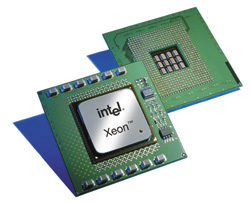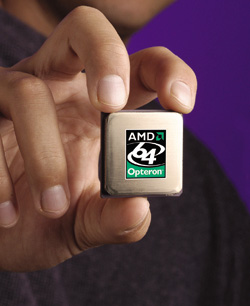64-Bit Battle Rages: Who Will Win the Duel?
Intel's new Xeon technology extends the processor's capabilities, throwing the gauntlet down at AMD Opteron's 64-bit feet.
Latest News
August 1, 2004
By Mark Devlin
As recently as December 2003, Intel denied it was developing an Opteron-like 64-bit processor. In February, Intel CEO Craig Barrett confirmed that the company was adding 64-bit capabilities to its 32-bit Xeon chip.
Admitting the development, which Barrett called “the worst-kept secret in San Francisco,” has been judged as being difficult for the world’s largest chipmaker. Some observers have said it required integrity, humility, and most of all, courage. Courageous, possibly, but smart, definitely.
“Since day one,” says AMD Opteron 200 Series Product Manager Gina Longoria, “Intel has been saying that Opteron is the wrong approach—until they announced the 64-bit Xeon.”
Longoria’s expected jab at Intel underscores the fact that its decision to develop new technology is at least partially related to the potential of losing some of the x86 market to AMD’s Opteron. Intel’s new line of transition processors include both 32- and 64-bit extensions in an apparent effort to head off that threat.
 Open House vs. Area 51
Open House vs. Area 51 Since Barrett’s announcement, much of the media has presented Intel as the sleazy kid who used to look over your shoulder to get test answers. The lion’s share of this has to do with Intel’s being indicted for reverse engineering Opteron. In this case, reverse engineering conjures up images of covert teams working in a dimly lit, soundproofed, and bug-swept Area 51. In Intel’s defense, there’s a distinction between reverse engineering and using public documents to engineer a competitive product.
“That’s true,” says Longoria. “Ours is an industry-standard x86 architecture. We’ve released all of our documentation so anyone could design 64-bit extensions.”
Opteron is based on the AMD64 architecture; Intel’s new competitive processor will be based on Intel Extended Memory 64 Technology, or EM64T. While the EM64T-based Xeon will, in fact, be positioned squarely against Opteron as a 32-/64-bit transition processor to adroitly run today’s 32-bit and tomorrow’s 64-bit OSs and applications, it will not replace Intel’s Itanium. Itanium will forge ahead, with ongoing enhancements, in high-end, RISC-competitive markets.
So, why did Intel choose the Opteron-competitive path instead of pursuing a unique approach? “It is our opinion,” says Jon Sharp, director of platform marketing for Intel Enterprise Products, “that there would have been no value to us taking a wholly different approach that would cause a bifurcation of the market and instruction set.”
There’s also that annoying little matter of operating systems. AMD’s Longoria remarks, “Microsoft has said that they will develop only one 64-bit OS, and it will support both Xeon and Opteron.”
64 Bitness“EM64T is all about extending memory,” says Sharp. “Whether or not you see any performance improvement will largely depend on whether the application was memory-constrained to begin with. We expect that the vast majority of applications that will run on this platform will continue to be 32-bit for a number of years to come. It will only be worth the time and trouble to port applications to 64 bits if they are running into memory constraints today.”
Datasets in many engineering applications have grown so large that EM64T, or “64-bitness” as Sharp puts it, will quickly become an important, application performance-improving tool for DE’s readers.
Both Opteron (as well as Athlon 64) and Xeon with EM64T (when it becomes available) will run Windows XP 64-Bit Edition. Betas were released in December, trial editions good for 360 days are available now, and the production version is set for release in the second half of this year. Both processors will also run the same 64-bit applications. (But neither will run Itanium-specific OSs or apps.)
Does that mean Xeon with EM64T will be an Opteron clone? Not according to Longoria: “There are a few minor instructions that are different in our architectures. These differences do not affect compatibility, however.” Could one organization using both AMD64 and EM64T use the same OS and apps? “Absolutely,” says Longoria.
“Intel has said that the 64-bit Xeon ‘will be compatible with Opteron, but we have entirely different architectures.’ We completely agree with that,” she says. “The Opteron architecture does a lot more than just allow for 64-bit computing. Intel does not have several features that we have. For example, we have an integrated memory controller. In a traditional architecture, you have go through the North Bridge in order to access memory. Opteron integrates the memory controller onto the CPU, enabling direct access to memory, which reduces memory latency and improves performance of memory-intensive applications.
“EM64T has a traditional North Bridge architecture,” Longoria continues, “so even though they’ll run AMD64-compatible applications, they’re still going to have that bottleneck of going through the North Bridge. The North Bridge architecture also creates a bottleneck to get to I/O. Opteron eliminates this bottleneck.”
On Bridging DifferencesWhile Intel’s Sharp would not commit to future implementations, he did allow that “today, we use the North Bridge. Different implementations have different advantages and disadvantages. There are tradeoffs,” he says. “There are certain application environments where AMD’s integrated memory controller will help. There are certain environments where it won’t. On the Intel implementation, what you get is a more flexible platform design so that you don’t have to spin the CPU in order to get access to next-generation memory.”
Below: Intel’s EM64T architecture will be used to
extend the Xeon processor into 64-bit
computing, competing directly with AMD’s Opteron.
 For example, Sharp explains that Intel is implementing DDR2 memory this year, which “provides higher performance at lower power. In order for AMD to take advantage of that, they have to spin the whole CPU; we just do it in the North Bridge. It’s easier, quicker, and we’ll be able to get out there and support DDR2 faster.”
For example, Sharp explains that Intel is implementing DDR2 memory this year, which “provides higher performance at lower power. In order for AMD to take advantage of that, they have to spin the whole CPU; we just do it in the North Bridge. It’s easier, quicker, and we’ll be able to get out there and support DDR2 faster.”
Sharp adds, “Another area that you’re trading off is that, in order to gain access to all memory and full memory bandwidth in the Opteron solution, you have to have another CPU in the machine to use its memory controller. If you don’t have that extra CPU, you’re not able to access as much memory as you otherwise would.”
Sharp says their upcoming Xeon will also support PCI Express. In a graphics environment, he says, PCI Express provides significantly more bandwidth to the graphics controller. “If you look at the Opteron design, and you’re accessing memory from the second CPU, then you’re going from memory to CPU number 2 to CPU number 1 to the graphics controller and then out,” says Sharp. “It’s a three-hop graphics interface between memory on one side to graphics controller on the other. With us, it’s just one hop, straight through the North Bridge.
“There are some differences between our instruction set architectures,” Sharp concludes. “They’re not large. For example, we do not support 3DNow, and AMD at this point does not support Streaming-SIMD (Single Instruction, Multiple Data) Extensions 3.”
Both firms state that while minor processor differences exist, users will not require compatibility patches to run the same applications on either system.
Left: Blazing the transition chip trail since development began in 1999, the Opteron processor line has expanded to include low-power HE (55W) and EE (30W) models for high-density apps, such as Blade servers, and other uses where cooling is difficult.
What Do We Call This Thing?Interestingly, a Xeon is a Xeon is a Xeon. The new processor will have no differentiating name. When the EM64T technology is added to the Xeon server and workstation line, it will be considered the same as any other added capability.
Sure, it’s an apples-to-apples comparison, but one load of apples hasn’t yet arrived. Intel will roll out EM64T in Xeon two-way server and workstation products starting with its Nocona launch in the second quarter of this year. The 64-bit version of Prescott for high-end desktops and workstations using a single processor will come later this year. Next to arrive in early 2005 will be a high-volume unit for multiprocessor use. Runs 32-bit applications well, and will perform even better once 64-bit OS and apps are in place? Check. Windows 64? Here, with a better one coming. Windows apps? EMT64T will certainly enhance traction of 64-bit application development.
How, if at all, will AMD64 and EM64T differences affect benchmark numbers and real-world performance? It remains to be seen. By this, the third installment of As the Processor Spins, we had expected to deliver more concrete answers. As it turns out, even with Opteron’s successes, 32-/64-bit is still in its infancy. Next time, we’ll attempt to compare boxes and run the benchmarks. Now that Intel has admitted 32-/64-bit computing is viable, everyone wins: Intel, AMD and, more importantly, the rest of us.
Mark Devlin is a freelance writer and analyst specializing in technology and manufacturing topics. Contact him via e-mail c/o Desktop Engineering Feedback.
AMC Corp.
212-620-0700
website
Intel Corp.
408-765-8080
website
Subscribe to our FREE magazine, FREE email newsletters or both!
Latest News
About the Author
DE’s editors contribute news and new product announcements to Digital Engineering.
Press releases may be sent to them via [email protected].







